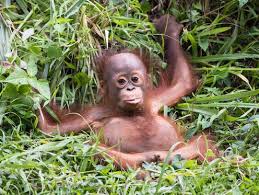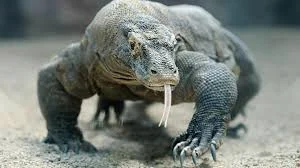Monkey Business; The Disappearing Habitat Of Boneo’s Orangutans.
The title for this piece is perhaps a little ambiguous as it will revolve around the orangutans of Borneo and Sumatra, rather than the Gibbons or the Proboscis monkeys of that region. The monkey business reference in the title refers to many of the dubious practices that take place on this, the world’s third largest island.
The orangutan is, of course a giant ape and, in many ways just one- step removed (evolutionary speaking) from the human species. They are the most arboreal of the great apes and spend most of their time hanging around in trees. Their hair is typically reddish-brown, (a little like Donald Trump’s mane) instead of the brown or black hair typical of chimpanzees and gorillas. Orangutans are the most solitary of the great apes, with social bonds occurring primarily between mothers and their dependent offspring, who stay together for the first two years.
They are among the most intelligent primates; they use a variety of sophisticated tools and construct elaborate sleeping nests each night from branches and foliage. In 2014 the WWF listed the orangutan as being severely endangered and the Sumatran orangutan categorized as critically endangered !
Who can resist an Orangutan?
Well, quite a few actually.
For starters, try the palm oil production companies or the illegal loggers or the coal and gold miners who in the last thirty years have decimated two thirds of Borneo’s magnificent rainforests. The upshot of this is that the orangutan’s habitat is fast shrinking along with the habitats of all other tree dwelling species as the forest burns; chainsaws roar and giant 200-year-old trees fall.
Palm Oil producers are possibly the worst culprits with their dubious practices with the resulting effect on this fragile environment being cataclysmic. Vast tracts of land are required for palm oil plantations to be productive and that land is ‘acquired,’ more often than not in the most dubious of ways with subsistence farmers being the losers. Once the land has been secured the clearing begins and the preferred method is fire!
Forest fires are deliberately lit and each year and millions of acres of ancient trees simply go up in smoke. In 2015, in Borneo’s central Kalimantan saw the worst forest fires in living memory with the smoke haze so bad that the main airports in Kuala Lumpur in Malaysia and far away Singapore forced to close for up to 48 hours! The residents of the region’s capital, Palankaraya had to wear protective surgical face - masks for weeks on end just in order to breathe!
This environmental disaster has been pretty much ignored by the rest of the planet even though each and every year the ‘lungs of the world’ are being systematically destroyed!Palm oil plants are easy to farm and the yields are high but these rather ugly trees are in fact a blight as, when their life cycles are complete not much else can be grown, as all the nutrients will have been sucked out the soil. This is classic short term thinking for quick returns, while the acrobatic gibbon, the shy proboscis monkeys and of course the majestic orangutan habitats are rapidly shrinking and will one day soon they will no longer be with us.
I strongly maintain that the more people who make the journey to visit these critically endangered species the more attention will be bestowed upon them. There are two ways to see the orangutans, those in the wild, or those in the numerous ‘rehabilitation’ centers scattered throughout Sarawak and Kalimantan.
The rehabilitation centers are the easiest, although I found it rather circus -like with the antics at feeding time almost scripted for the adoring tourists who flock to these sanctuaries. One of the easiest to get to is the Semenggoh Wildlife Centre just a few miles outside Sarawak’s capital, Kuching (on the Malaysian side of Borneo)
Here 29 orangutans live in just 650 acres of preserved rainforest. Unfortunately for a troupe this size the area is far too small. However you will have the opportunity to get up close and personal as they swing acrobat like towards the various feeding stations.
Rehabilitation is a wonderful concept although it has yet to be proven successful. Those in ‘captivity ‘ will have contact with humans and naturally pick up strains of bacteria not known to those orangutans in the wild. When released, it has been found that the wild orangutans will succumb to easily to human diseases from which they have no immunity.
Having said that, if you have never had the experience of seeing an orangutan, the centre will not disappoint even though up to five hundred tourists visit each feeding time!They are simply adorable to look at, highly intelligent with their basic use of tools and their ability to reason. I read a report recently from Atlanta Zoo where two orangutan females now play competitive video games!
It has been noted that in this particular sanctuary the alpha males will actually plan their day in advance, working out times to move around and scout out various locations where they will spend the night. For those more adventurous and wanting to see orangutans in the wild it is best to venture to the wonders of Kalimantan.
The Gamung National Park just across the border from Sarawak in West Kalimantan is the least visited national park in Indonesia. The density of wildlife is astonishing and if you are lucky you may spot the rare and incredibly shy maroon langur.
There are an estimated 2,000 – 2,500 orangutans living in the park so you are sure not to be disappointed. The Kutai National Park in East Kalimantan is another gem where an estimated 700 orangutans reside although logging and oil palm plantations are slowly but surely creeping ever closer. Access is easy via the city of Samarinda but be sure to get your permit at the small town of Batang close to the main gate.
Tourism, in the case of the orangutans, is a good thing, as the more people who visit will surely bring more and more pressure to their plight. The more people notice the more noise people make, simple.
Borneo is the world’s third largest island and home to thousands of fauna and flora species that mankind has yet to discover!
As I end, I will end as I do so many of my other travel stories; “If you never go, you’ll never know.”
Photographs Copyright Paul v Walters & E.J.Lenahan















